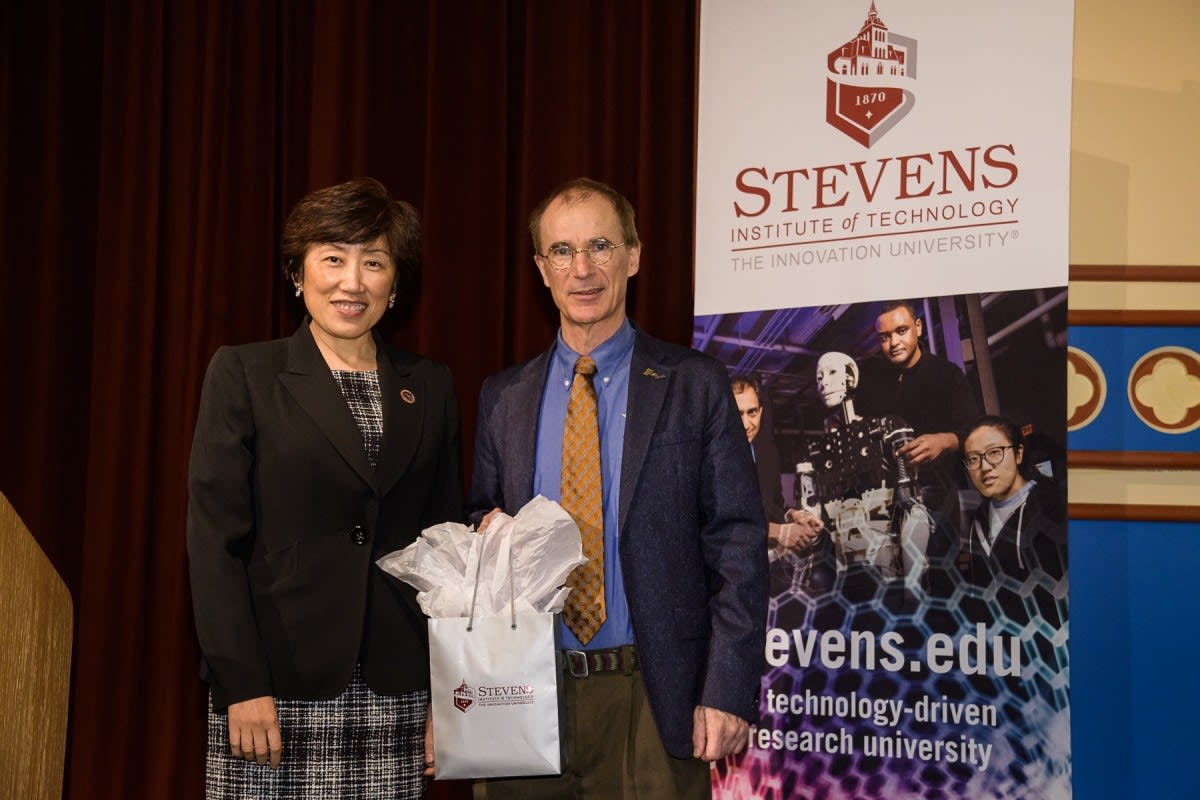Space is the future of science experimentation.
That was the theme of second Dean’s Lecture Series from the Charles V. Schaefer, Jr. School of Engineering and Science at Stevens Institute of Technology. Held on Wednesday, October 17 in DeBaun Auditorium, the lecture was an inspiring call to action for faculty and student researchers to consider the International Space Station as their next laboratory.
As presented by Dr. Randy Giles, chief scientist of the International Space Station’s U.S. National Research Laboratory, ISS offers "a wide-scale research and development program" that furthers scientific discovery and technological innovations by offering access to performing experiments in space. The U.S. government invests $3 billion annually into this lab, and the opportunities for research are vast.
Giles’ talk, titled "The ISS U.S. National Laboratory: Research and Development in Low Earth Orbit," was a succinct but comprehensive overview of the environment, projects and equipment available to academic researchers. "The ISS National Laboratory offers a unique research environment," he said, "from microgravity, to the exposure to extreme conditions of space and a unique vantage point traveling over 90 percent of the Earth’s population."
The benefits of research in space
Researchers may have never considered using the space station’s national laboratory for their experiments, but half its equipment—from centrifuges and incubators to rodent research facilities and vegetable gardens—is allotted to experiments in life sciences, physical sciences, remote sensing and technological development.
"This looks like a lot—and it is,” Giles said, referencing a series of slides showcasing the lab’s cutting-edge and consistently upgraded equipment and experiment setups, "but this only scratches the surface of our capabilities."
One piece of equipment is a light microscopy module (LMM), a highly flexible, state-of-the-art light imaging microscope enabling life and physical science microscopic research. Another is an additive manufacturing facility (AMF) which creates on-demand parts. Another is the materials science research rack (MSSR), a system allowing for discovery of new properties in metals, alloys, polymers, semiconductors, ceramics, crystals and glasses for biomedical and commercial uses. The newest piece of equipment is the cold atom lab (CAL) which observes and measures quantum phenomena undetectable from Earth.
The goal of all the equipment is to conduct experiments "that benefit life on Earth," Giles said. Many of them revolve around understanding the way the human body loses bone density and experiences muscle atrophy, decreased immune function and slowed heartbeat in response to life above gravity. That information is vital to helping humans one day live in space—but also imperative to researchers studying those conditions on Earth right now. As Giles put it, "if you study osteoporosis, why wait for patients to age into the disease when you can study astronauts?"
Another major area of experimentation include studying how other living organisms like rodents, plants and cells function in space. Researchers on the national lab have discovered that without the effects of gravity, rodents not only experience similar bodily degeneration but also behave differently. Plants, cells and microbes experience genetic changes mutations different from ones they naturally go through on Earth, and this new gene expression is important to anti-aging research and disease modeling. "Pathogens become more pathogenic in space," Giles said. "We’re not sure why yet, but by performing these experiments in space we’re creating more models to learn how they evolve so we can treat them better."
Emerging industries in space
Aside from creating new knowledge, the ISS National Laboratory is also creating new industries 1200 miles above the Earth’s surface.
Space manufacturing is the most promising—and surprising. "Sometimes, it’s more cost-effective to manufacture a material in space and ship it back to Earth," Giles said. The prime example is ZBLAN fiber optic glass, which is better than the silica used in most fiber optic cables but is incredibly difficult to manufacture on Earth due to extreme crystallization. That crystallization doesn’t occur in space, resulting in a higher quality material that could lead to better communication technologies.
Other emerging industries include quickly bioprinting stem cells to become organs and combat the organ shortage crisis, and creating more sustainable, water-conservation friendly ways to manufacture cotton.
"Imagine what you can do in space."
Right now, the majority of the users taking advantage of these opportunities are corporations like Novartis, Merck, Procter & Gamble Target, Hewlett Packard, Apple, AIRBUS, Honeywell, Orbital Sidekick, OrbitFab. Some academic institutions, like Stanford University, Cornell University and Georgia Institute of Technology, are starting to take advantage of the opportunities afforded by the lab.
But Giles would like to see more.
"More and more academics are advising on our projects," he said, " we’re happy to collaborate with even more."
The ISS is open to almost any research project. But this year’s objectives focus on three key research areas: tissue engineering, advanced materials and nanomaterials. Sustainability is a promising emerging research area.
In order to participate, researchers must submit proposals. If accepted, ISS will work with them to find them a partner who will make their experiment suitable for space, then ship it up to the lab to be worked on by its crew of astronaut researchers. They can also ship materials back down, if necessary. "We’re not the investigators," Giles clarified, "we’re the ones that help."
Giles closed with a call to action reminding faculty and students that there truly is no limit to their research: "Imagine what you can do in space."
This is the second Dean’s Lecture Series offered by the Schaefer School of Engineering and Science. The purpose of this series is to bring STEM innovators and thought leaders together with students and faculty to share wisdom, inspire discovery and nurture an entrepreneurial spirit to help build a world-class, prominent school of engineering and science. Click here to learn more.



